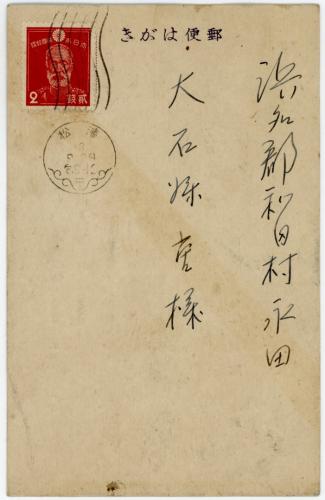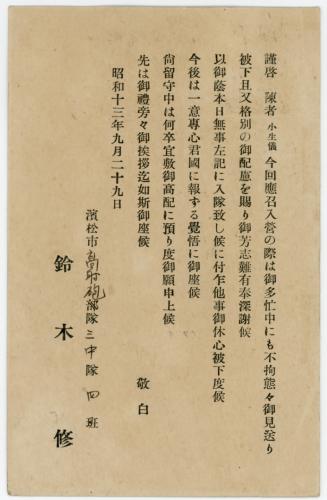19-08-2025, 12:01 AM
This is an example of a shussei tsūchi hagaki (出征通知葉書) That is, a pre-printed Mobilization Notice Postcard. A “Departure for the Front Notification” postcard. Newly enlisted soldiers were expected to send them to relatives and employers once their reporting date was fixed.
It was addressed in 1943 and sent to Tsuchiya Yoshio, [care of the] Ichikawa household, 7 9 Ōokayama, Meguro ku, Tokyo.

Stamp: Japan
General Nogi Maresuke (1849-1912) [Hero of the Russo-Japanese War]
Issued on May 10, 1937
2s, Scarlet
SG 318
2 sen was the domestic postcard rate at the time. As the sender was not yet in the military, this was not sent 'free' but required civilian postage and travelled through the ordinary mail system.
Cancel:
It appears to be a machine cancel with six wavy lines. The wavy line obliterator looks like it is enclosed in a box which is different than western usage.
Single ring dater die 鶴見 / 18 / 6 . 3 [Tsurumi, June 3, 1943 (Shōwa 18)] Tsurumi, or Tsurumi-ku is one of the wards [ku] of the city of Yokohama.
There is an ornamental scroll with the character for Post in the bottom portion of the dater die.
Tsurumi [the posting office] sits on the Tōkaidō Main Line about 25 km south west of Meguro. The card probably reached Tokyo the same day or early the next morning.
Postcard:
On the front of the rather rough, buff coloured card, at the top, are the words 郵便はがき [Postcard] The paper stock and the blotchy printing suggest that by 1943 higher grade materials were being diverted for military needs.
Pre-printed Message: On the back of the card is printed a standard message (based on machine translation)
With profound respect,
At this crucial moment, as our Great Japanese Empire lays the foundations for its next hundred years, it is a comfort to learn that you remain in continued good health and tireless endeavor.
Through good fortune I have been permitted to take part in the supreme task of breaking through the present national crisis.
This is thanks entirely to the guidance and support I have received from you and all the others, for which I offer heartfelt gratitude.
On the occasion of my departure for the front you extended many kindnesses; please accept my deepest thanks.
After entering the ranks I shall devote myself single mindedly to the complete fulfillment of the national policy, and I beg you therefore to set your mind at ease.
I write in haste to convey my thanks and this brief notice.
The year (Shōwa 18 / 1943) and the month (6) are pre-printed on the card. The sender was supposted to add the day in the space provided. The sender of this card did not do so.
Manuscript addition: The sender added his name Nakamura Tatsuo and the name of the unit to which he is being posted ... 千葉市 歩兵第七十二部隊 [Chiba shi Infantry Regiment No. 72]
This regiment was established in 1938 in Chiba. It was deployed in China and in the Philippines.

Here is another example of a (出征通知葉書) Mobilization Notice Postcard from the start of the war.
It's from Shōwa 13 (1938), five years earlier. At that time, Japan was engaged in a full-scale war in China (Second Sino-Japanese War). It had started in the summer of 1937.
The 1938 card was sent to a Mr. Ōishi at Nagamizuta Hamlet, Hatsuō (初生) Village, Hamana District (now, Hamamatsu City in Shizuoka Prefecture).

It was posted on September 29, 1938 by Suzuki Osamu newly posted to the 4th Squad, 3rd Company of the Hamamatsu Anti-Aircraft / Artillery Detachment.
While they are very similar in function (and have the same stamp, postcard rate and postmark type), there are a few interesting differences between this card and the one above.
For example, the paper is of somewhat higher quality (firmer) and the type and printing is darker and cleaner.
The paper shortage was not yet as challenging as it would become by 1943.
Also, the pre-printed message on the back is also a bit different. It appears to read:
With respectful greetings.
When I was called up and entered camp, you were kind enough, despite your many duties, to come personally to see me off and to extend special courtesies; I am deeply grateful.
Thanks to your support I have today safely joined the unit listed at left; pray set your mind at ease.
Henceforth I am firmly resolved to devote myself single heartedly to repaying our Sovereign and Country.
I beg that, during my absence, you will continue to favour me with your kind guidance.
I write first to tender my thanks and respectful salutations.
Shōwa 13, 29 September

In my view, the 1938 version of the message is more like a polite personal letter. He thanks his friends and family who had come to see him off and promises to do his duty.
The 1943 version, on the other hand, appears to have shifted into the realm of war propaganda. There was no mention of a send-off and the language has shifted to talking about 'breaking through the crisis'.
While soldiers in other parts of the world were asked to 'write home' as soon as they were posted (often with a 'check the box' pre-printed card) these Japanese cards are new to me.
I'm going to see if I can find a series of these cards over the the 30's an 40's and trace the evolution of these messages. I'd be interested in seeing how the language of mobilization hardens as the war unfolds.
Cheers, Hugh
It was addressed in 1943 and sent to Tsuchiya Yoshio, [care of the] Ichikawa household, 7 9 Ōokayama, Meguro ku, Tokyo.
Stamp: Japan
General Nogi Maresuke (1849-1912) [Hero of the Russo-Japanese War]
Issued on May 10, 1937
2s, Scarlet
SG 318
2 sen was the domestic postcard rate at the time. As the sender was not yet in the military, this was not sent 'free' but required civilian postage and travelled through the ordinary mail system.
Cancel:
It appears to be a machine cancel with six wavy lines. The wavy line obliterator looks like it is enclosed in a box which is different than western usage.
Single ring dater die 鶴見 / 18 / 6 . 3 [Tsurumi, June 3, 1943 (Shōwa 18)] Tsurumi, or Tsurumi-ku is one of the wards [ku] of the city of Yokohama.
There is an ornamental scroll with the character for Post in the bottom portion of the dater die.
Tsurumi [the posting office] sits on the Tōkaidō Main Line about 25 km south west of Meguro. The card probably reached Tokyo the same day or early the next morning.
Postcard:
On the front of the rather rough, buff coloured card, at the top, are the words 郵便はがき [Postcard] The paper stock and the blotchy printing suggest that by 1943 higher grade materials were being diverted for military needs.
Pre-printed Message: On the back of the card is printed a standard message (based on machine translation)
With profound respect,
At this crucial moment, as our Great Japanese Empire lays the foundations for its next hundred years, it is a comfort to learn that you remain in continued good health and tireless endeavor.
Through good fortune I have been permitted to take part in the supreme task of breaking through the present national crisis.
This is thanks entirely to the guidance and support I have received from you and all the others, for which I offer heartfelt gratitude.
On the occasion of my departure for the front you extended many kindnesses; please accept my deepest thanks.
After entering the ranks I shall devote myself single mindedly to the complete fulfillment of the national policy, and I beg you therefore to set your mind at ease.
I write in haste to convey my thanks and this brief notice.
The year (Shōwa 18 / 1943) and the month (6) are pre-printed on the card. The sender was supposted to add the day in the space provided. The sender of this card did not do so.
Manuscript addition: The sender added his name Nakamura Tatsuo and the name of the unit to which he is being posted ... 千葉市 歩兵第七十二部隊 [Chiba shi Infantry Regiment No. 72]
This regiment was established in 1938 in Chiba. It was deployed in China and in the Philippines.
Here is another example of a (出征通知葉書) Mobilization Notice Postcard from the start of the war.
It's from Shōwa 13 (1938), five years earlier. At that time, Japan was engaged in a full-scale war in China (Second Sino-Japanese War). It had started in the summer of 1937.
The 1938 card was sent to a Mr. Ōishi at Nagamizuta Hamlet, Hatsuō (初生) Village, Hamana District (now, Hamamatsu City in Shizuoka Prefecture).
It was posted on September 29, 1938 by Suzuki Osamu newly posted to the 4th Squad, 3rd Company of the Hamamatsu Anti-Aircraft / Artillery Detachment.
While they are very similar in function (and have the same stamp, postcard rate and postmark type), there are a few interesting differences between this card and the one above.
For example, the paper is of somewhat higher quality (firmer) and the type and printing is darker and cleaner.
The paper shortage was not yet as challenging as it would become by 1943.
Also, the pre-printed message on the back is also a bit different. It appears to read:
With respectful greetings.
When I was called up and entered camp, you were kind enough, despite your many duties, to come personally to see me off and to extend special courtesies; I am deeply grateful.
Thanks to your support I have today safely joined the unit listed at left; pray set your mind at ease.
Henceforth I am firmly resolved to devote myself single heartedly to repaying our Sovereign and Country.
I beg that, during my absence, you will continue to favour me with your kind guidance.
I write first to tender my thanks and respectful salutations.
Shōwa 13, 29 September
In my view, the 1938 version of the message is more like a polite personal letter. He thanks his friends and family who had come to see him off and promises to do his duty.
The 1943 version, on the other hand, appears to have shifted into the realm of war propaganda. There was no mention of a send-off and the language has shifted to talking about 'breaking through the crisis'.
While soldiers in other parts of the world were asked to 'write home' as soon as they were posted (often with a 'check the box' pre-printed card) these Japanese cards are new to me.
I'm going to see if I can find a series of these cards over the the 30's an 40's and trace the evolution of these messages. I'd be interested in seeing how the language of mobilization hardens as the war unfolds.
Cheers, Hugh
Hugh MacDonald, Wolfe Island
Member: BNAPS. PHSC, Auxiliary Markings Club, Postal Stationary Society, British Postmark Society,
AMG Collectors Club, China Stamp Society, France and Colonies Philatelic Society
ArGe Deutsche Feldpost: 1914-1918 e.V.

